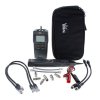As I have referred earlier, our new home is getting constructed and would be delivered in couple of months.
I would like to thank all of you for your suggestions & guidance on designing the CC locations & which models to choose from.
I've bought about 21 Dahua cameras with Andy and they have been delivered promptly. I got CAT6 home run around the house where I want the cameras to be installed.
The builder would not allow a certified contractor work on until the settlement is done.
I'm planning to go with Ubiquiti Dream Machine Pro, 48 port POE switch & AP installed in my AV Rack where the cables are home run.
Unfortunately, the CAT6 nor the speaker wire cables are labelled at the home run. I would have to crimp both ends of CAT6 and run it through Keystone Patch panel.
I would like to know what exact test tools are recommended to identify each nodes, test out that Keystone jacks are installed properly and mainly how to test the IP Cams - check the angle at each location.
From what I've read, looks like Koolertron is a good tool to use for testing.
Any opinons or other suggestions? Do we even need an IPCam tester like above or just a ethernet test kit will work like this -
Thanks!
I would like to thank all of you for your suggestions & guidance on designing the CC locations & which models to choose from.
I've bought about 21 Dahua cameras with Andy and they have been delivered promptly. I got CAT6 home run around the house where I want the cameras to be installed.
The builder would not allow a certified contractor work on until the settlement is done.
I'm planning to go with Ubiquiti Dream Machine Pro, 48 port POE switch & AP installed in my AV Rack where the cables are home run.
Unfortunately, the CAT6 nor the speaker wire cables are labelled at the home run. I would have to crimp both ends of CAT6 and run it through Keystone Patch panel.
I would like to know what exact test tools are recommended to identify each nodes, test out that Keystone jacks are installed properly and mainly how to test the IP Cams - check the angle at each location.
From what I've read, looks like Koolertron is a good tool to use for testing.
Amazon.com : Koolertron Upgraded 7 inch IPS Touch Screen H.265 4K IPC-9800 Plus IP Camera Tester CCTV CVBS Analog Tester Built in WiFi with POE/WIFI/8G TF Card/HDMI Output/RJ45 TDR/Dual Window Test/Firmware : Camera & Photo
Amazon.com : Koolertron Upgraded 7 inch IPS Touch Screen H.265 4K IPC-9800 Plus IP Camera Tester CCTV CVBS Analog Tester Built in WiFi with POE/WIFI/8G TF Card/HDMI Output/RJ45 TDR/Dual Window Test/Firmware : Camera & Photo
www.amazon.com
Any opinons or other suggestions? Do we even need an IPCam tester like above or just a ethernet test kit will work like this -
Thanks!
As an Amazon Associate IPCamTalk earns from qualifying purchases.



